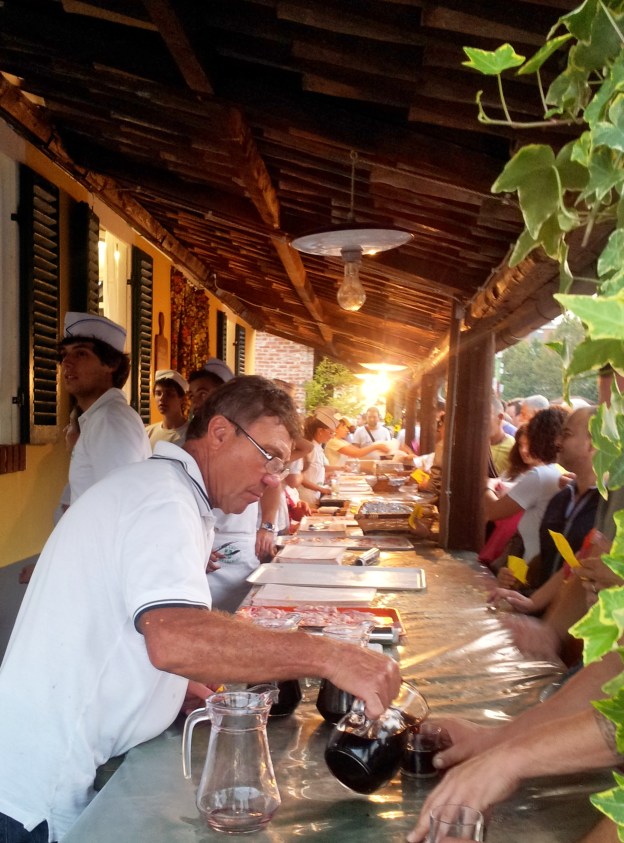“Does asino mean what I think it–”
“Sure does.”
“Alrighty then. How many plates shall we get?”
Asino is Italian for donkey, and the context was a food stall selling meat-stuffed pasta. I’d gone with some friends to the Festival delle Sagre — the Festival of Festivals — a weekend food festival in Asti, south of Torino. Imagine an agricultural show/county fair with a ferris wheel, but with almost all the exhibits being food stalls. There must have been at least 50 of them. And not nasty showgrounds food. Each stall featured one or two freshly-made dishes, the local specialties of villages in a region known internationally for its food.
And now add in the fact that every stand has wine, typically included in the price of food. And you can buy an empty glass that comes with a holder so you can wear it around your neck as you walk around. Genius!
As soon as we’d arrived, we realized we were going to need a strategy for all this. We started with a reconnaisance — walking around, sussing out what options there were. Truffle risotto! Polenta with wild boar! The options were dizzying. By the time we were halfway through our recon run, it was getting hard to not buy everything in sight.
Once we had the lay of the land, we decided on our first stop, which was by far the highlight of the savoury options — friciula, a fried bread-y-pastry-y thing, with fatty pancetta. It came recommended to us, and it was a good call. Fat and starch and salt and everything delicious. “It’s funny, everyone back in England seems to think Italian food is healthy,” said S. We looked at what we were eating and laughed.
Our second stop was the agnolotti d’asino, the donkey pasta. I have to admit, I’m not really a huge meat eater and while I could tell the pasta was different to others I’ve had, I don’t know how much was the donkey meat and how much was the flavourings they used. It was tasty, but. And a good discussion starter — if horse is ok to eat, why not donkey? Or to go a step back towards Australian thinking — if cow is ok to eat, why not horse…?
While we were walking around, thinking about what to get next, we hit on the optimal food-finding strategy: hang around the central area where the tables were, look at what other people are eating, and if it looked good, ask them where it was from. It was through this, plus a discussion of whether polenta is similar to ugali, that we ended up with polenta and wild boar stew. (The verdict: polenta is not like ugali, but it is good.)
At this point we were extremely full. “No you finish the polenta; no you; no really, I can’t” level of full. We had to make some serious decisions about desserts. I think we got it right: zabaglione (custard but amazing custard made with wine not, like, custard powder custard), and “chocolate salami”, which is possibly the best chocolate slice I’ve ever had (it doesn’t contain salami, if you were wondering). Two very different options, both delicious.
It was a happy sleepy train ride home, full of food and wine. We are so doing this again next year.



Well, I guess I missed out! Sounds absolutely delicious, and I’m glad you’ll be doing it again. The wine holders are hilarious, by the way.
LikeLike
You did! though I hear Salone del Gusto is coming up pretty soon… :D
LikeLike
Horse meat/donkey meat? Well…my motto is “never eat your ass!”
LikeLike
So why is it called ‘chocolate salami’? I think I would be too aware of donkeyness to eat donkey meat. It’s only familiarity that allows me to eat any meat.
LikeLike
Chocolate salami does look a bit like salami http://en.wikipedia.org/wiki/Chocolate_salami though I have no idea why you’d think to make a chocolate dessert that looks like cured meat…
LikeLike
Pingback: Notes from my extremely glamorous life: way too much food edition | Where's Zoe now?
Pingback: I went to Salone del Gusto and the only photo I got was this taxidermy boar wearing sunglasses. (I am such a bad blogger.) | Where's Zoe now?